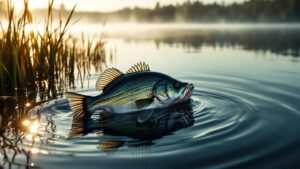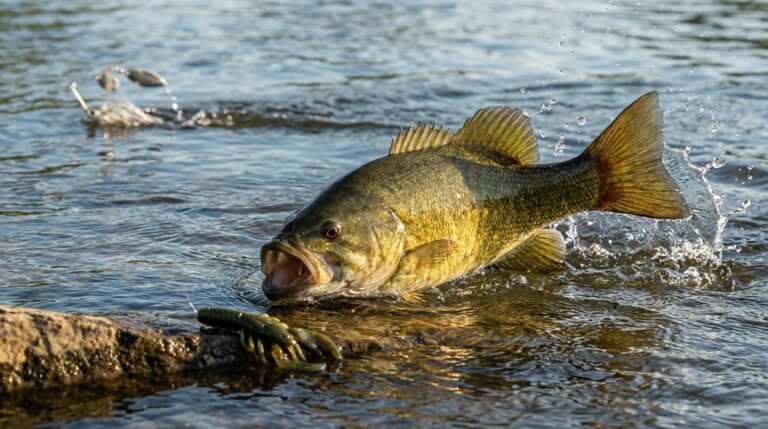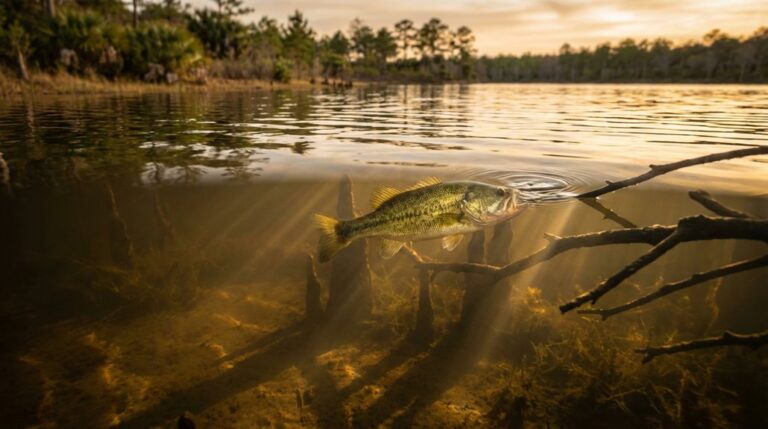Black bass belong to the Micropterus genus and include 13 distinct species, with Largemouth and Smallmouth being the most well-known. You'll find these predatory fish across North America, from Hudson Bay to Mexico, each with unique characteristics and habitat preferences. While Largemouth prefer warm, vegetated waters, Smallmouth thrive in cooler, rocky environments. Understanding each species' distinct traits, behaviors, and seasonal patterns will transform your fishing success.
Scientific Classification and Taxonomy
While many anglers know black bass as powerful gamefish, these freshwater predators belong to a precisely defined scientific hierarchy.
You'll find black bass classified within the family Centrarchidae and genus Micropterus, which includes 13 distinct species. The most recognized members of this group are the Largemouth bass (Micropterus salmoides) and Smallmouth bass (Micropterus dolomieu).
The scientific classification places these fish under Kingdom Animalia, Phylum Chordata, Class Actinopterygii, and Order Perciformes.
Native to North America, black bass species range from Hudson Bay to northeastern Mexico. Some species, like the Guadalupe bass, are endemic to specific regions, which makes habitat conservation essential for their survival.
This diversity within the genus showcases nature's remarkable adaptation to different freshwater environments.
Historical Distribution and Range
Before human intervention altered their ranges, black bass species inhabited vast stretches of North American waterways from Canada's Hudson Bay to Mexico's northeastern regions.
You'll find the Largemouth Bass has maintained the most extensive historical distribution, thriving in diverse freshwater habitats across the continent.
The Smallmouth Bass's native range originally covered Central and Eastern North America, but you can now find this popular sportfish in over 20 countries worldwide.
Texas claims the endemic Guadalupe Bass, which you'll only naturally find in the northern and eastern Edwards Plateau region.
The Alabama Bass, along with several other black bass species, has expanded beyond its original territory through introductions to various states.
These intentional stockings have appreciably changed the natural distribution patterns of many black bass species.
Physical Characteristics and Identification
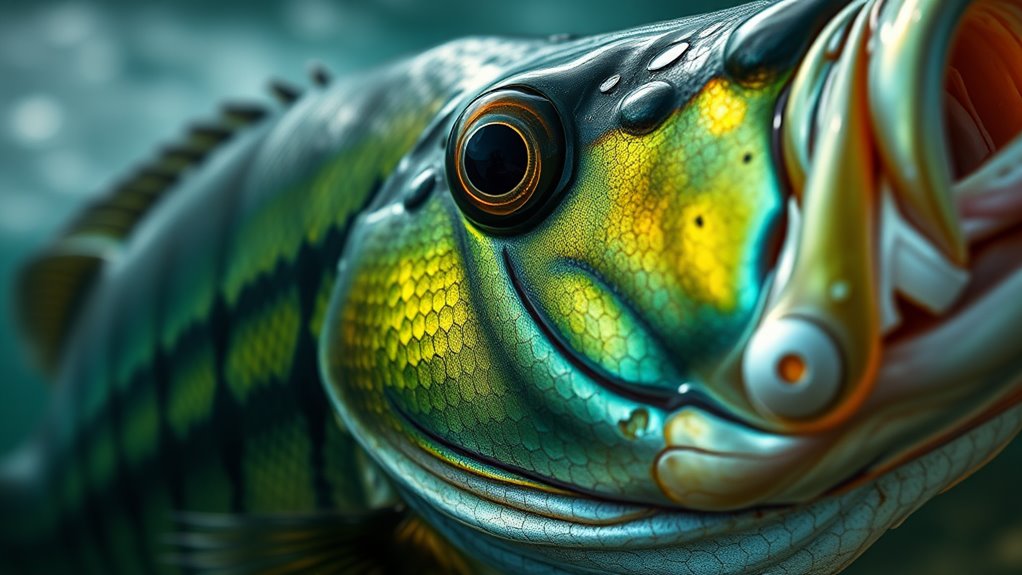
Identifying black bass species in the wild requires understanding their distinct physical features, much like mapping their historical ranges.
You'll notice that all black bass share a streamlined body shape and flattened head with a large mouth adapted for predatory feeding.
When you're examining physical characteristics, focus on coloration and markings. Largemouth bass display a dark green body with a prominent lateral line, while smallmouth bass show a bronze hue with vertical bars.
You can spot Alabama bass by their distinctive blotches above the lateral line that don't reach the dorsal fin. Redeye bass stand out with olive coloring and bright red-orange fin markings.
The Suwannee bass features unique bluish tints on its cheeks and belly, while Guadalupe bass shows a deeper green coloration compared to its spotted bass cousin.
Habitat Preferences and Requirements
The six main species of black bass each gravitate toward distinct habitats that suit their survival needs.
You'll find Largemouth bass in warm, vegetated freshwater habitats, while Smallmouth bass prefer cooler, clearer waters with rocky bottoms.
Alabama bass thrive in flowing pools of small to medium river systems, and the Guadalupe bass calls the fast-moving waters of Texas' Edwards Plateau home.
Spotted bass favor areas with plenty of structure, like submerged rocks and fallen trees.
The Suwannee bass has the most specific habitat requirements, living exclusively in select Florida rivers.
Unfortunately, these diverse habitats face increasing threats from habitat degradation and competition from non-native species, putting pressure on black bass populations, particularly the Suwannee bass and other specialized species.
Feeding Behavior and Diet Patterns

When it comes to feeding habits, black bass display remarkable versatility as opportunistic predators throughout their lifecycle.
You'll find their diet patterns vary considerably by species, with largemouth bass targeting larger prey while smaller species focus on insects and invertebrates. During the spawning season, they exhibit particularly aggressive feeding behavior.
Key feeding characteristics of black bass include:
- Primary diet consists of plankton, aquatic invertebrates, crayfish, and smaller fish
- Most active feeding during dawn and dusk, especially for larger specimens
- Seasonal changes affect their feeding patterns, with increased activity in warmer months
- Prefer to ambush prey from cover, demonstrating their predatory nature
You'll notice their feeding behavior adapts to environmental conditions, moving to deeper waters during colder periods while maintaining their opportunistic hunting strategy. Additionally, their feeding habits are influenced by optimal fishing conditions, which can enhance catch potential during specific times of the day.
Spawning Cycles and Reproduction
Understanding black bass reproduction cycles reveals a remarkable annual process that peaks during spring months.
You'll find black bass reaching sexual maturity between 1 and 3 years of age, setting the stage for their spawning season from March to June when water temperatures warm to 64-79 degrees Fahrenheit.
During spawning, male bass construct shallow nests near the shoreline. Once females lay eggs in these nests, they can produce thousands of eggs that'll hatch over several days.
The male's dedication is evident as he stays vigilant, guarding the nest against potential predators throughout the incubation period.
Under favorable conditions, black bass can live 10-12 years, with some reaching 15 years. This extended lifespan allows for multiple spawning cycles, ensuring the species' continued success in suitable habitats.
Notable Species Descriptions
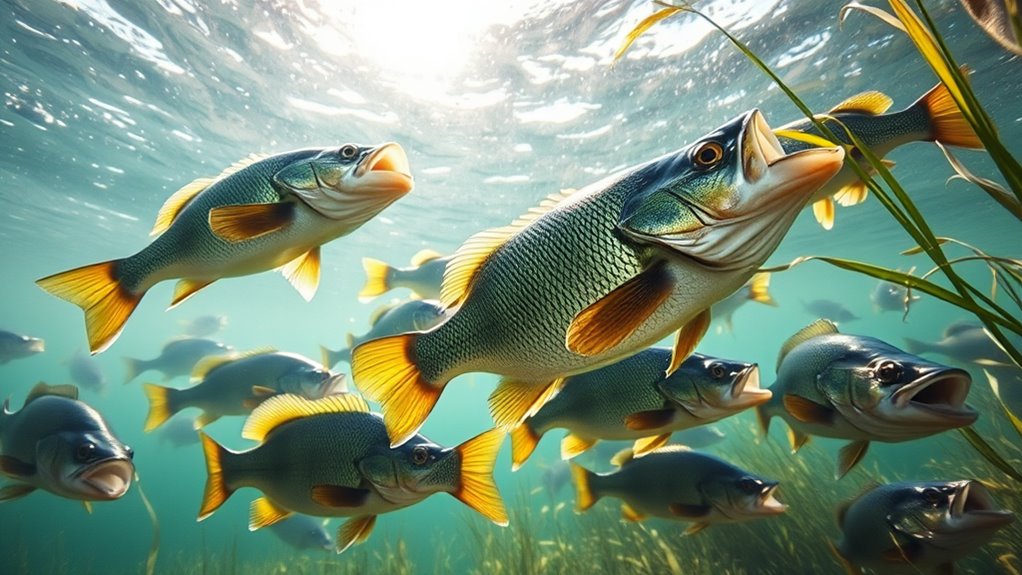
Among North America's prized game fish, black bass species showcase distinctive traits that set them apart from one another.
You'll find the Alabama Bass reaching impressive trophy sizes over 20 inches, while the Florida Bass contributes to record catches through hybridization.
The Guadalupe Bass, Texas' state fish, thrives in fast-flowing waters, and the Redeye Bass displays unique coloration with its striking brick red fins.
- The Alabama Bass dominates the Mobile River drainage, with a California record of 10 lbs 4 oz
- Florida Bass shows exceptional longevity and growth potential
- Guadalupe Bass can reach 17 inches and 3.71 pounds
- Suwannee Bass prefers structure-rich environments with distinctive bluish hues
Each species requires specific fishing techniques tailored to their habitat preferences and behavioral patterns.
Conservation Status and Threats
Although most black bass species maintain stable populations with a "Least Concern" conservation status, the Shoal and Suwannee bass face increasing challenges that have earned them a "Near Threatened" classification.
Habitat loss from urban development, farming practices, and environmental pollution poses the most critical threat to these species, particularly affecting those with limited ranges.
You'll find that non-native species introductions and hybridization present additional challenges, potentially compromising genetic diversity in native black bass populations.
The Guadalupe bass, Texas's endemic species, exemplifies these concerns as it struggles with both habitat degradation and hybridization threats.
To protect these valuable species, ongoing monitoring and habitat restoration initiatives are vital, especially in areas where human activities have greatly impacted their environments. Additionally, understanding bass behavior can aid in conservation efforts by promoting sustainable fishing practices that minimize impact on their habitats.
Angling Techniques and Best Practices
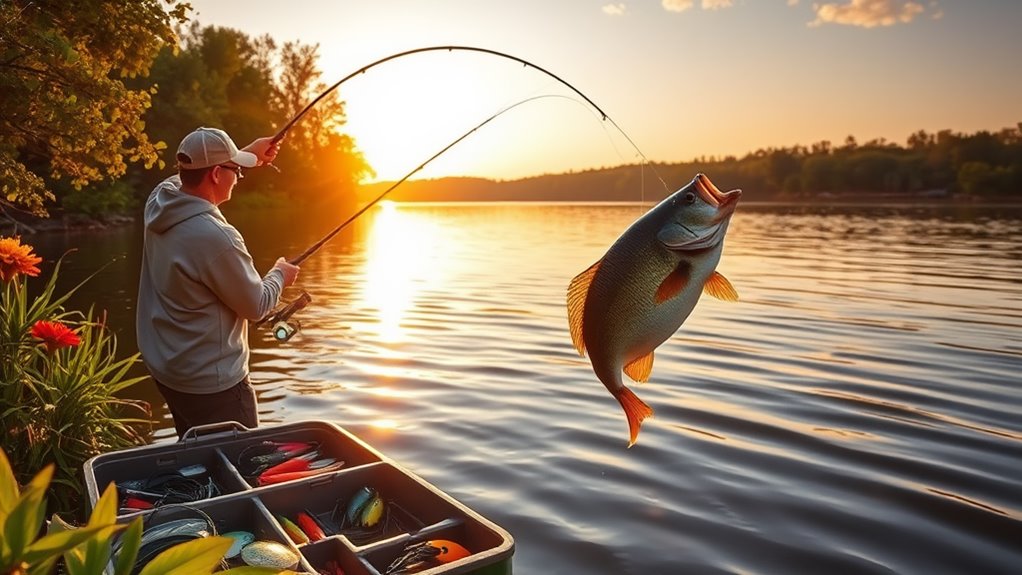
When you're targeting black bass, successful angling depends on matching your techniques to seasonal patterns and environmental conditions. Your lure selection and presentation should adapt to water temperature and seasonal behaviors, especially during spawning periods when bass become more aggressive around their nests.
- Use crankbaits and spinnerbaits in varying water conditions, switching to topwater lures near vegetation during warm months.
- Apply finesse techniques like ned rigs in cooler seasons when fish suspend in deeper water.
- Target early morning or late evening periods during summer months for better surface action.
- Employ Texas rigging when fishing around structure to minimize snags.
Understanding these patterns and adapting your approach accordingly will greatly improve your black bass fishing success throughout the year. Additionally, selecting the right rod power and action, such as medium power with fast action, can enhance your sensitivity and control when fishing for bass.
Research Developments and Studies
The scientific understanding of black bass continues to evolve as genetic research reveals greater species diversity within the Micropterus genus. You'll find that scientists have now confirmed nine distinct species, with several new additions identified in 2013, including the Chattahoochee bass.
Recent studies show that hybridization threatens several species, particularly the Guadalupe bass, which faces challenges from interbreeding with Smallmouth bass.
You'll need to understand that genetic testing and morphological analysis have become essential tools in distinguishing between closely related species.
Conservation efforts are increasingly critical, as some species like the Shoal and Suwannee bass are now classified as Near Threatened. Their survival depends on protecting their habitats and managing competition from other species, highlighting the complex challenges in preserving black bass diversity.
Frequently Asked Questions
How Long Can Black Bass Survive Out of Water?
You'll find that black bass can survive 2-4 minutes out of water in ideal conditions. If you're catch-and-release fishing, it's best to return them quickly to avoid stressing or harming the fish.
Can Different Black Bass Species Successfully Crossbreed in the Wild?
Yes, you'll find that different black bass species can and do crossbreed in the wild. It's most common between smallmouth and spotted bass, or largemouth and spotted bass, though these hybrids may have reduced fertility.
Do Black Bass Remember Being Caught and Avoid Similar Lures?
Yes, you'll find that bass can learn from negative experiences. They'll often become more wary after being caught and may avoid similar lures for a while, though they don't typically have long-term memory of specific lures.
What Is the Average Lifespan of Black Bass in Captivity?
You'll find that black bass can live 10-16 years in captivity when properly cared for. In ideal conditions with good water quality, nutrition, and minimal stress, they'll often outlive their wild counterparts by several years.
Can Black Bass Change Their Coloration to Match Their Surroundings?
Yes, you'll notice black bass can subtly adjust their coloration to blend with their habitat. They'll appear darker in murky waters or around dark cover, and lighter in clear waters or sandy bottoms.
Final Thoughts
Black bass species remain a cornerstone of North American freshwater ecosystems and sport fishing. You'll find these adaptable fish continue to face challenges from habitat loss and climate change, but their popularity drives ongoing conservation efforts. Whether you're an angler or researcher, understanding black bass behavior, habitat needs, and conservation status will help guarantee these remarkable species thrive for future generations to study and enjoy.

